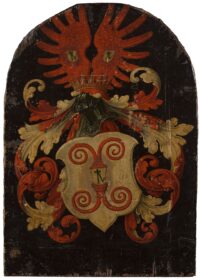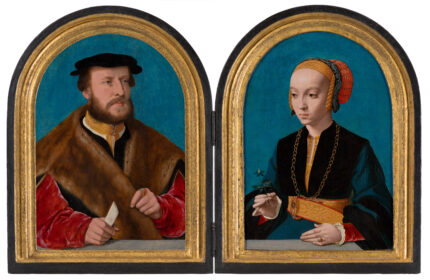The Mauritshuis museum has acquired the portrait of Jakob Omphalius, reuniting him with his fiancée Elisabeth Bellinghausen 150 years after the diptych celebrating their union was granted an unwanted divorce.
The oil-on-panel double portrait was painted by Bartholomäus Bruyn the Elder (1493-1555) in 1538/9. Bruyn was the leading portait painter for the elite of Cologne, founder of a the first school of portraiture in the city. His realistic style was inspired by artists like Hans Holbein the Younger, and like Holbein, he was meticulous in capturing the details of their luxurious clothing and jewelry. He specialized in diptychs of engaged and married couples. Even though portraits formed the bulk of his output, Bartholomäus Bruyn did not sign them. He signed his religious art only, and attributions of his portraiture spring from stylistic comparisons with the signed pieces.
As is typical of his couple diptychs, the couple in the Mauritshuis are painted against a plan blue background. The groom looks right, the bride left off the frame, towards each other, and a marble ledge or counter begins in the man’s portrait and ends in the female one. This couple was engaged, not yet married, as attested to by the sprig of bittersweet, symbolizing a fiancee in the visual vernacular of Cologne portraiture.
The portrait of Elisabeth Bellinghausen was donated to the Rijksmuseum in 1912. At that time, only the author of the painting was known, not the identity of the sitter. In 1951, the portrait went on display at the Mauritshuis  on long-term loan from the Rijksmuseum. Mauritshuis curators identified her as one of the daughters of University of Cologne law professor Peter Bellinghausen by the coat of arms on the back of the panel, but he had four daughters and there was no hint of which one this young lady might be.
on long-term loan from the Rijksmuseum. Mauritshuis curators identified her as one of the daughters of University of Cologne law professor Peter Bellinghausen by the coat of arms on the back of the panel, but he had four daughters and there was no hint of which one this young lady might be.
The breakthrough came in 2004 when curator Ariane van Suchtelen discovered an old black-and-white photo of a portrait of a man that matched this one at the Netherlands Institute for Art History (RKD) and an 1896 auction catalogue listing both portraits for sale. They were unidentified and misattributed to Jan Gossaert. The catalogue had handwritten notes by art historian Hofstede de Groot which included sketches of the coats of arms on the back of the portraits. Curators were able to trace the coat of arms and discover the identity of the man: Jakob Omphalius, a prominent lawyer and law lecturer at the University of Cologne. He was married to Peter Bellinghausen’s daughter Elisabeth and together they would go on to have 13 children.
The happy couple were now recognized as such and known by their proper names, but the whereabouts of Jokab’s portrait were unknown since it had lost been documented at auction in 1955. In May 2019, a “portrait of an unknown man” was sold at a small Paris auction to a Geneva art gallery. The curator of a German museum saw it was the long-lost Jakob portrait and alerted the Rijksmuseum which alerted the Mauritshuis. With the financial support of the national lottery, foundations and a private donor, the Mauritshuis was able to purchase the portrait of Jakob Omphalius and reunite him with his bride.
New frames for the portraits of Jakob Omphalius and Elisabeth Bellinghausen have been made, based on another example by Bruyn. As a result, the portraits once again look like a diptych as they were originally intended (the original frames had been largely lost).
The portrait of Elisabeth has previously undergone extensive conservation treatment at the Mauritshuis. The ‘diptych’ will be displayed in the museum until 4 October, after which time the portrait of Jakob will also undergo extensive treatment in the museum’s conservation studio. The paintings, which now both form part of the Dutch national art collection, will then once again be on view as a diptych in the Mauritshuis.

Only been to the Mauritshuis a couple of times but it has a fantastic collection. The display and lighting of perfectly maintained paintings has few equals in the world of museums. They had a “poor box” for donations and were displaying a Rubens purchased with donations when I was last there. It is fantastic when art history research leads to new information and acquisitions.
My name is Grace Elisabeth Bellinghausen, I’ve known of this painting for a while and I’m overjoyed that now it’s complete. Thank you. Glad my ancestors are safe now. :hattip:
Good to see that they are back together. Elisabeth is a Bellinghausen just like my Gradfather Wilhelm Bellighausen from Cologne a Ginger and my Daughter a Ginger living for several years now in Amsterdam. The Similarity to the Crest on the Ring of my Grandfather is obvious as is the Similarity to Christop von Bellinghausen Fürst Abt of Corvey.